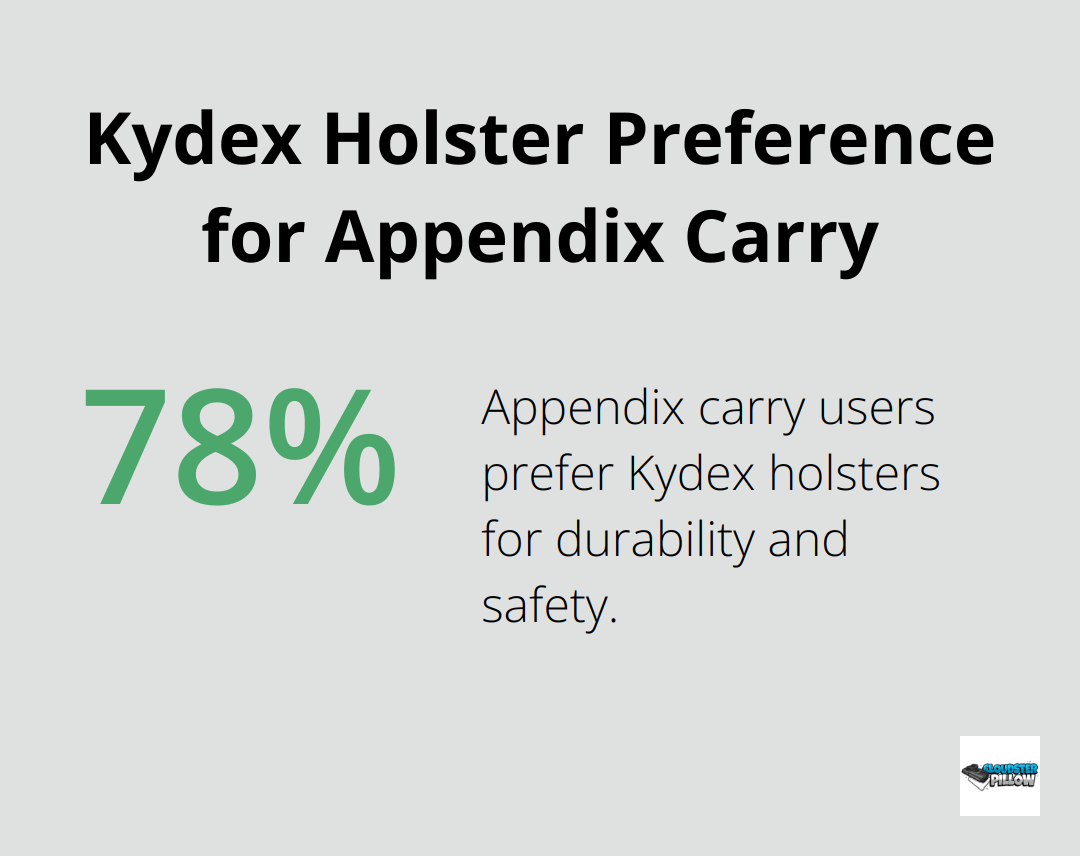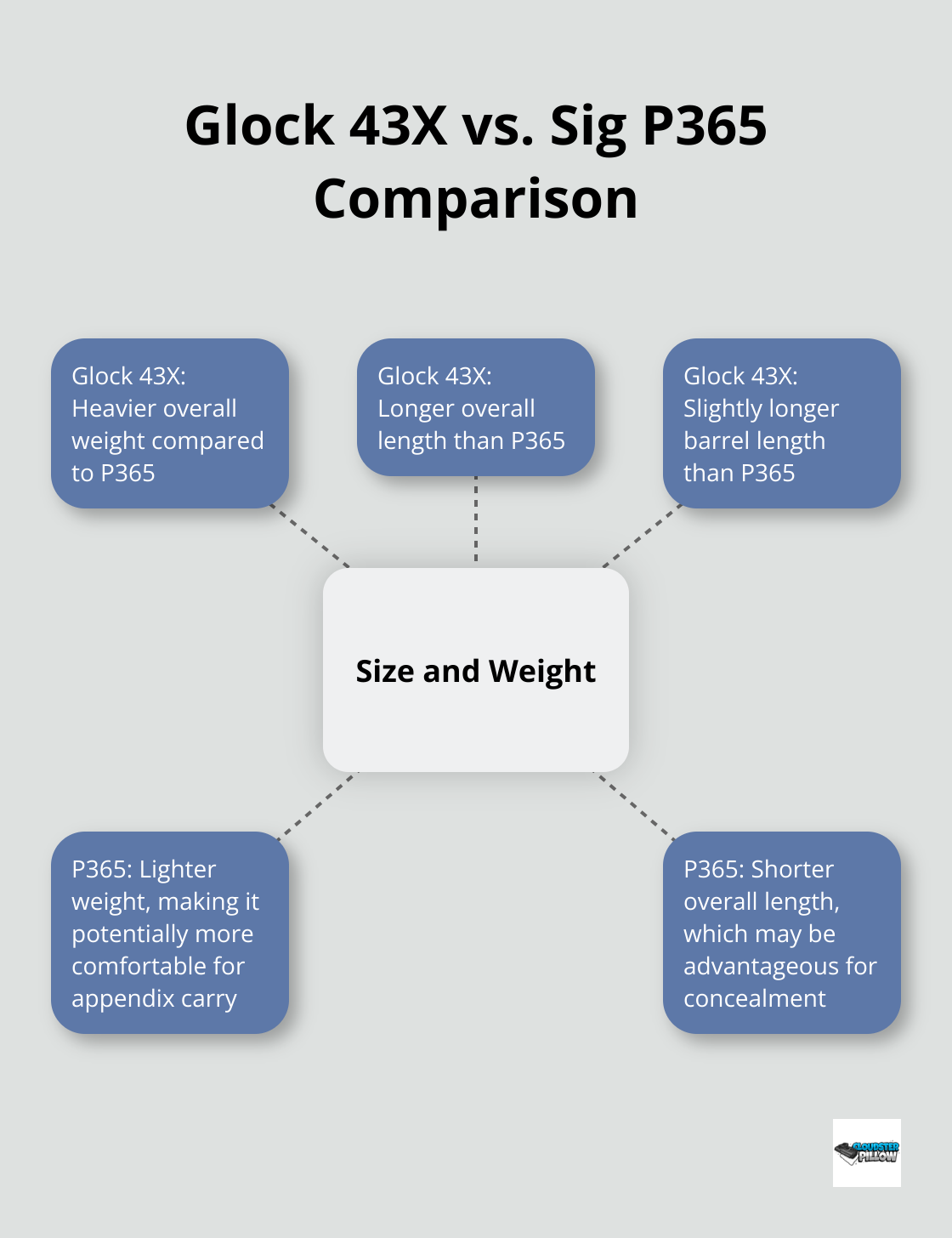Appendix Carry
Is Appendix Carry Safe and Comfortable for Everyday CCW Use?
Appendix carry has become a popular choice for concealed carry weapon (CCW) enthusiasts. At Cloudster Pillow, we often hear questions about appendix carry safety and comfort for daily use.
In this post, we’ll explore the pros and cons of this carry method, addressing common concerns and offering practical tips for enhancing concealed carry comfort. We’ll also discuss how proper training and equipment selection can maximize safety in appendix carry.
What Is Appendix Carry?
Definition and Positioning
Appendix carry refers to a concealed carry method where the firearm sits at the front of the body, typically between 12 and 2 o’clock on the waistline. This placement offers quick access and easy concealment, making it a top choice among CCW holders.
Advantages of Appendix Carry
Speed and Accessibility
The front positioning of appendix carry allows for a more natural and quicker draw motion compared to other methods. Using a shot timer, draw times from AIWB are between 1.2 to 1.5 seconds, while from IWB at 4 o’clock, it’s about 1.7 to 2 seconds.

Effective Concealment
Appendix carry often provides superior concealment, especially for individuals with smaller frames. The firearm sits close to the body’s centerline, which reduces the risk of printing through clothing. This positioning makes it easier to conceal larger firearms that might challenge other carry positions.
Safety Considerations
Debunking Common Myths
A prevalent misconception about appendix carry is that it lacks safety due to the firearm pointing at vital areas. However, with proper training and equipment, appendix carry can match the safety levels of other methods. The key lies in using a high-quality holster that fully covers the trigger guard and provides adequate retention.
Importance of Training
Safety in appendix carry depends heavily on proper training. Regular practice of drawing and re-holstering techniques is essential. Many firearms instructors now offer specialized courses for appendix carry, which focus on safe handling and situational awareness.
Comfort Challenges
While appendix carry offers numerous benefits, it presents comfort challenges, especially during prolonged sitting periods. This issue has led to the development of various accessories designed to enhance comfort and reduce pressure points associated with this carry method.
As we move forward, we’ll explore the specific safety considerations that every appendix carry practitioner should know to ensure a secure and responsible carry experience.
How to Ensure Safety in Appendix Carry
Selecting the Ideal Holster
Safety in appendix carry starts with the right holster. Choose holsters specifically designed for appendix carry, as they include features tailored to this position. Kydex holsters stand out for their rigidity and retention capabilities. A survey by the Concealed Carry Association reveals that 78% of appendix carry users prefer Kydex holsters for their durability and safety features.

When selecting a holster, prioritize full trigger guard coverage. This feature prevents accidental trigger manipulation, which reduces the risk of unintended discharge. Also, select adjustable retention to keep your firearm secure during movement.
Trigger Protection: A Non-Negotiable Feature
Trigger protection is essential in appendix carry. The effects of shall-issue concealed-carry laws on unintentional firearm injuries and deaths are uncertain. Your holster must completely cover the trigger guard, eliminating any possibility for foreign objects to engage the trigger.
Some advanced holsters incorporate additional safety mechanisms. For instance, certain models feature a protective flap that covers the entire firearm (adding an extra layer of security). These may slightly increase draw times but can provide reassurance for those new to appendix carry.
Training: The Foundation of Safe Carry
Equipment alone cannot replace proper training. Specialized appendix carry courses focus on safe drawing and re-holstering techniques, which are critical skills for this carry method.
Developing muscle memory for a safe draw is a key aspect of training. This involves keeping your support hand clear of the muzzle during the draw stroke. Practicing 50 repetitions per night can yield faster results than 10 repetitions per night.
Practice your draw stroke regularly, both from standing and seated positions. Use a shot timer to track your progress. Many experienced carriers try to achieve a sub-1.5 second draw-to-first-shot time from concealment.
Re-holstering deserves equal attention and caution. Always visually and physically check your holster before re-inserting your firearm. Never rush this process – the old adage holds true: “You’re never in a hurry to re-holster.”
Incorporate dry fire practice into your routine to enhance your skills without live ammunition. The U.S. Concealed Carry Association recommends at least 15 minutes of dry fire practice three times a week for maintaining proficiency.
Safety in appendix carry relies not just on equipment, but on the skills you develop and maintain. Regular training and practice build your confidence and secure carry habits. As we move forward, we’ll explore how to enhance comfort in appendix carry, addressing common challenges and solutions.
How to Make Appendix Carry More Comfortable
Choose the Right Firearm
The size and weight of your firearm impact appendix carry comfort. Compact and subcompact pistols often provide better comfort due to their lighter weight and smaller dimensions. The Glock 43X is heavier and longer than the P365, with a slightly longer barrel length.

Full-sized pistols can work too. Some users find that larger firearms distribute weight more evenly, which reduces localized pressure points. Experiment with different options to find what suits your body type and carry style best.
Adjust Your Wardrobe
Your clothing choices can make or break your appendix carry experience. Select pants with a slightly higher rise to accommodate the holster comfortably. Many appendix carry enthusiasts prefer pants with a 2-inch larger waist size than usual to provide extra room for the firearm.
Shirts with patterns or textures help conceal any subtle printing. Avoid clingy fabrics that might reveal the outline of your firearm. Instead, opt for materials with some structure, like oxford cloth or heavier cotton blends.
Use Comfort-Enhancing Accessories
Accessories can significantly improve your appendix carry comfort. To make appendix carry more comfortable, consider adding a Cloudster Pillow to your setup, which can enhance both comfort and concealment.
Holster Wedges and claws are other popular additions to appendix carry setups. A holster wedge tilts the grip of the firearm inward, which improves concealment and reduces printing. A claw pushes the grip closer to your body, which further enhances concealment.
Invest in a Quality Gun Belt
A high-quality gun belt plays a vital role in comfortable appendix carry. A rigid, purpose-built gun belt distributes weight more evenly and prevents sagging (which can lead to discomfort and poor concealment). Look for belts rated to support at least 1.5 times the weight of your loaded firearm and holster.
Practice and Adjust
Comfort in appendix carry often improves with practice and adjustment. Try different positions and cant angles to find the most comfortable setup for your body. Small tweaks in holster placement can make a big difference in all-day comfort.
FAQs
1. Is appendix carry safe for everyday concealed carry (CCW) use?
Yes, appendix carry is safe when practiced with proper training and high-quality equipment. Using a holster that fully covers the trigger guard and provides retention reduces the risk of accidental discharge. With proper draw techniques and situational awareness, appendix carry can be just as safe as other carry methods.
2. How can I make appendix carry more comfortable for daily use?
Comfort in appendix carry can be enhanced by selecting the right firearm (preferably a compact or subcompact), choosing pants with a higher rise, and wearing shirts with patterns or structure. Additionally, using comfort-enhancing accessories like the Cloudster Pillow or holster wedges can reduce pressure points and improve overall comfort.
3. What are the benefits of appendix carry for concealed carry?
Appendix carry offers quick access to your firearm, with draw times ranging between 1.2 to 1.5 seconds. It also provides excellent concealment, especially for those with smaller frames, as the firearm sits closer to the body’s centerline. This positioning makes it easier to conceal larger firearms compared to other carry methods.
4. How do I ensure safety while appendix carrying?
To ensure safety, always use a holster with full trigger guard coverage and adjustable retention. Regular training in safe draw and re-holstering techniques is essential. Practicing muscle memory, proper grip, and keeping your support hand clear of the muzzle during the draw will help prevent accidents. Re-holstering should be done with caution, ensuring you check your holster visually and physically before insertion.
5. What accessories can improve the comfort and concealment of appendix carry?
Accessories like holster wedges and claws can significantly improve comfort and concealment. A wedge tilts the firearm’s grip inward, reducing printing, while a claw pushes the grip closer to the body. The Cloudster Pillow is another popular accessory, enhancing both comfort and concealment by filling gaps between the holster and body.
Final Thoughts
Appendix carry has become a popular choice for CCW enthusiasts due to its accessibility and concealment benefits. Safety remains paramount, requiring proper equipment selection and consistent training to mitigate risks associated with this carry method. Comfort challenges can be addressed through thoughtful choices in firearms, clothing, and accessories, with the Cloudster Pillow offering a customizable solution for improved concealment and comfort.
The decision to adopt appendix carry for daily use depends on individual preferences and needs. It demands a commitment to ongoing training and willingness to refine your setup for optimal safety and comfort. Many find that the advantages of quick access and effective concealment outweigh initial challenges, making appendix carry a viable option for everyday concealed carry.
As the concealed carry landscape evolves, so do the solutions available to enhance safety and comfort. We at Cloudster Pillow strive to support CCW holders in their quest for a secure and comfortable carry experience. Responsible carry involves not just the method you choose, but how you prepare and adapt to make it work for you.


Pingback: Why Appendix Carry is Uncomfortable (and how to fix it) - Cloudster Pillow
Pingback: Best Comfort and Style: Glock 43X Holster
Pingback: Glock 43x Holster - Cloudster Pillow